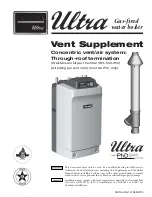
8
Environmental protection/disposal
SM290/2 5 | SM300/5 | SM400/5 | SM290/5E | SM400/5E – 6 720 800 023 (2013/01)
33
8
Environmental protection/disposal
Environmental protection is a fundamental principle of the
Bosch Group.
Quality of products, efficiency and environmental protection are equally
important objectives for us. All legislation pertaining to the environment
is strictly observed.
Packaging
We are dedicated in adhering to country-specific disposal standards as
they relate to packaging to ensure optimum recycling. All packaging
materials are environmentally compatible and can be recycled.
Used appliances
Used appliances contain materials that should be recycled.
The assemblies are easy to separate and the types of plastic used are
identified. This allows the various assemblies to be appropriately sorted
for recycling or disposal.
9
Maintenance
▶ Let the DHW cylinder cool down sufficiently prior to any maintenance
work.
▶ Carry out cleaning and maintenance procedures in the specified
intervals.
▶ Remedy all faults immediately.
▶ Only use genuine spare parts.
9.1
Maintenance intervals
Service the appliance in accordance with throughput, operating
temperature and water hardness (
Table 35, page 33).
The use of chlorinated DHW or a water softener unit reduce the service
intervals.
You can check the local water quality with your water supply utility.
Depending on the composition of the water, it can make sense to deviate
from the reference values listed.
9.2
Maintenance work
9.2.1
Checking the safety valve
▶ Check the safety valve annually.
9.2.2
Descaling/cleaning the DHW cylinder
▶ Disconnect the DHW cylinder on the DHW side from the pipework.
▶ Close the shut-off valves and isolate the immersion heater from the
power supply (if installed) (
Fig. 19, page 116).
▶ Drain the DHW cylinder (
Fig. 18, page 116).
▶ Check the DHW cylinder interior for contamination (lime scale
deposits, sediment).
▶
In the case of soft water:
Check the cylinder interior regularly and clean out any sediment
deposits.
-or-
▶
In the case of hard water or severe contamination:
Regularly descale the DHW cylinder in line with the actual amount of
limescale using chemical cleaning methods (e.g. with a suitable
descaling agent based on citric acid).
▶ Clean out the DHW cylinder interior with a water jet
(
▶ Remove the residues with a wet & dry vacuum cleaner with plastic
suction hose.
▶ Close the inspection aperture with a new gasket
(
▶ Re-commission the DHW cylinder (
9.2.3
Checking the magnesium anode
The magnesium anode is a sacrificial anode that is consumed when the
DHW cylinder is in use. Two types of magnesium anode can be used.
Fitted as standard:
A non-insulated magnesium anode (
Version A,
Fig. 27, page 118).
Available as an accessory:
An insulated magnesium anode
(
Version B, Fig. 27, page 118).
We recommend that insulated magnesium anodes are additionally
checked regarding the protective current using an anode tester on an
annual basis (
Fig. 25, page 118). The anode tester is available as an
accessory.
▶ Shut off the cold water inlet.
▶ Depressurize the DHW cylinder (
▶ Install and test the magnesium anode (
▶ Replace the magnesium anode if its diameter has been reduced to
below 15 mm.
▶ Check the transition resistance across the earth connection and the
magnesium anode.
Water hardness in °dH
3 – 8.4
8.5 – 14
> 14
Calcium carbonate concentration
in mol/ m³
0.6 – 1.5
1.6 – 2.5
> 2.5
Temperatures
Months
At a standard throughput (< cylinder content/24 h)
< 60 °C
24
21
15
60 – 70 °C
21
18
12
> 70 °C
15
12
6
At a higher throughput (> cylinder content/24 h)
< 60 °C
21
18
12
60 – 70 °C
18
15
9
> 70 °C
12
9
6
Table 35 Service intervals in months
In order to improve the cleaning effect, heat up the
indirect coils prior to cleaning them with a water jet. The
thermal shock effect separates deposits (e.g. lime scale
build-up) more readily.
The DHW warranty is void if the magnesium anode is not
correctly maintained.
Never bring the magnesium anode surface into contact
with oil or grease.
▶ Keep everything clean.
















































